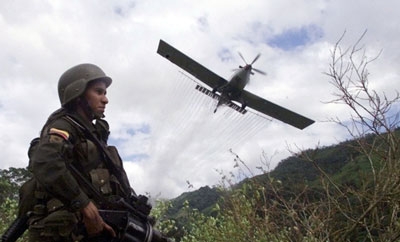A report calling for an end to aerial drug crop fumigation in Colombia presents compelling data to support its position, but the country’s political reality makes it unlikely any such reform will happen soon.
In a report published on October 7, the Washington Office on Latin America (WOLA) called on the United States and Colombian authorities to abandon their longstanding policy of aerial coca eradication, a central facet of counter-narcotics efforts in Colombia.
The program, which became a key element of the US-backed Plan Colombia, has been in place since 1994. Aircraft spray a powerful herbicide over the country’s coca-producing regions, covering an estimated 100,000 hectares of land each year, according to the report.
Colombia is currently the only country that uses aerial eradication, which officials say is necessary due to the threat posed by armed groups.
However, the expensive program appears to be less effective than its supporters claim. Increased fumigation rarely correlates with a decrease in coca production — in fact, Colombian coca cultivation began to decline after 2007, despite aerial fumigation efforts also dropping. On top of that, legal crops are often killed, ruining the livelihood of small-scale farmers.
The report points to the ongoing peace talks between the Colombian government and the country’s largest guerilla group, the Revolutionary Armed Forces of Colombia (FARC), as a potential opportunity to introduce the idea of ending aerial eradication efforts.

InSight Crime Analysis
Although the WOLA report presents a strong argument for ending fumigation, the reality of Colombia’s political situation provides little hope that it could happen in the near future.
Fumigation is highly unpopular and diminishes the government’s credibility among affected farming communities, who say it has negative economic, health and environmental effects; however, it remains a key element of bilateral relations with the United States.
Furthermore, government claims that aerial fumigation is the safest strategy are borne out by instances of violence committed by armed groups against manual eradicators, a fact that partly explains the recent decline of the practice. A police report in August noted that 62 workers have been killed and 387 more injured in manual eradication efforts since 2009.
The key to ending this is striking an agreement with the FARC. The guerrillas are the custodians of much of Colombia’s coca crop, which they protect with landmines and snipers, and so remain the biggest obstacle to manual eradication attempts.

